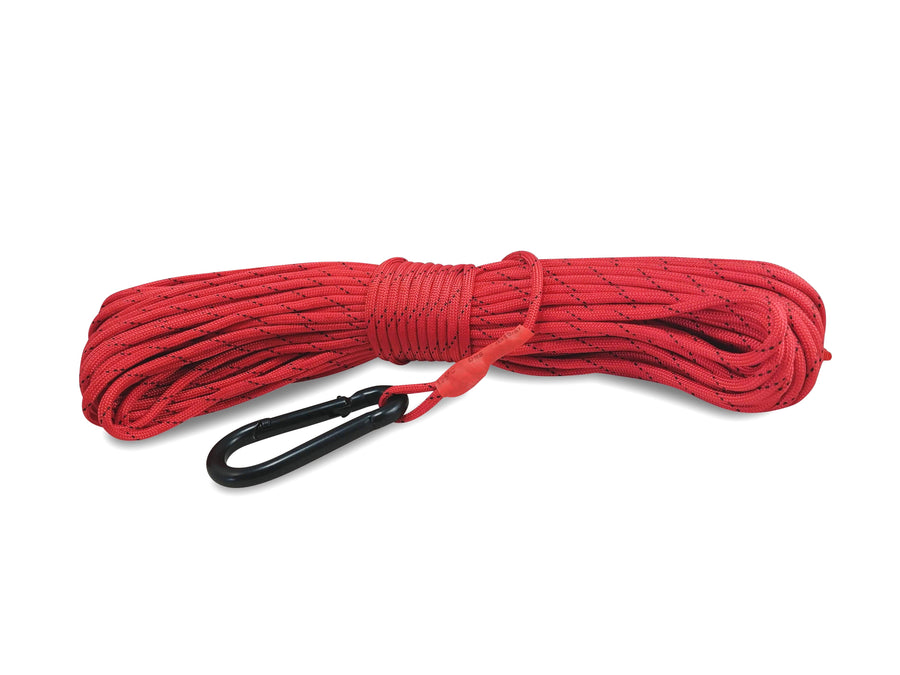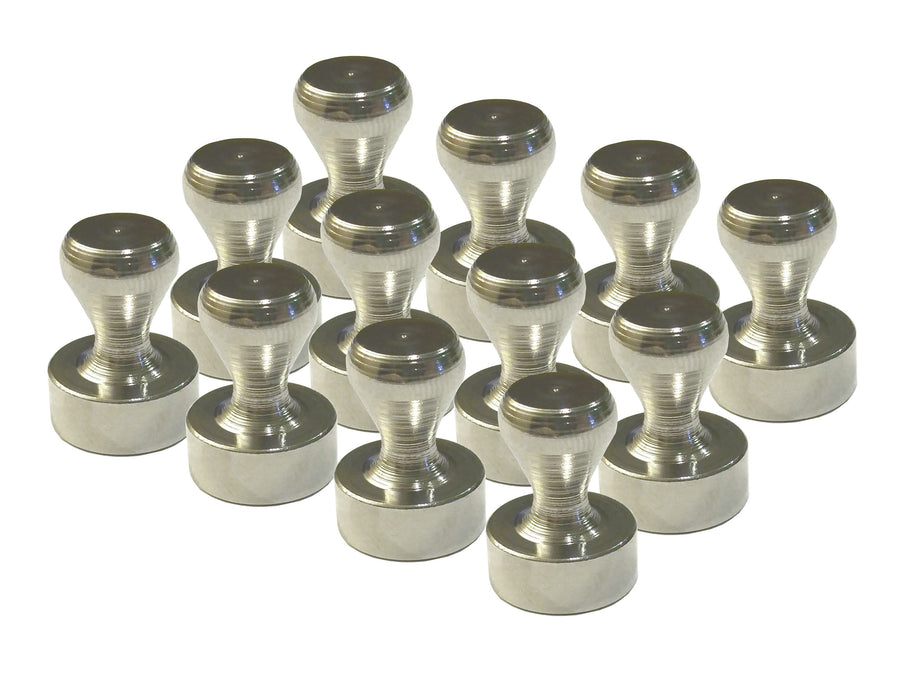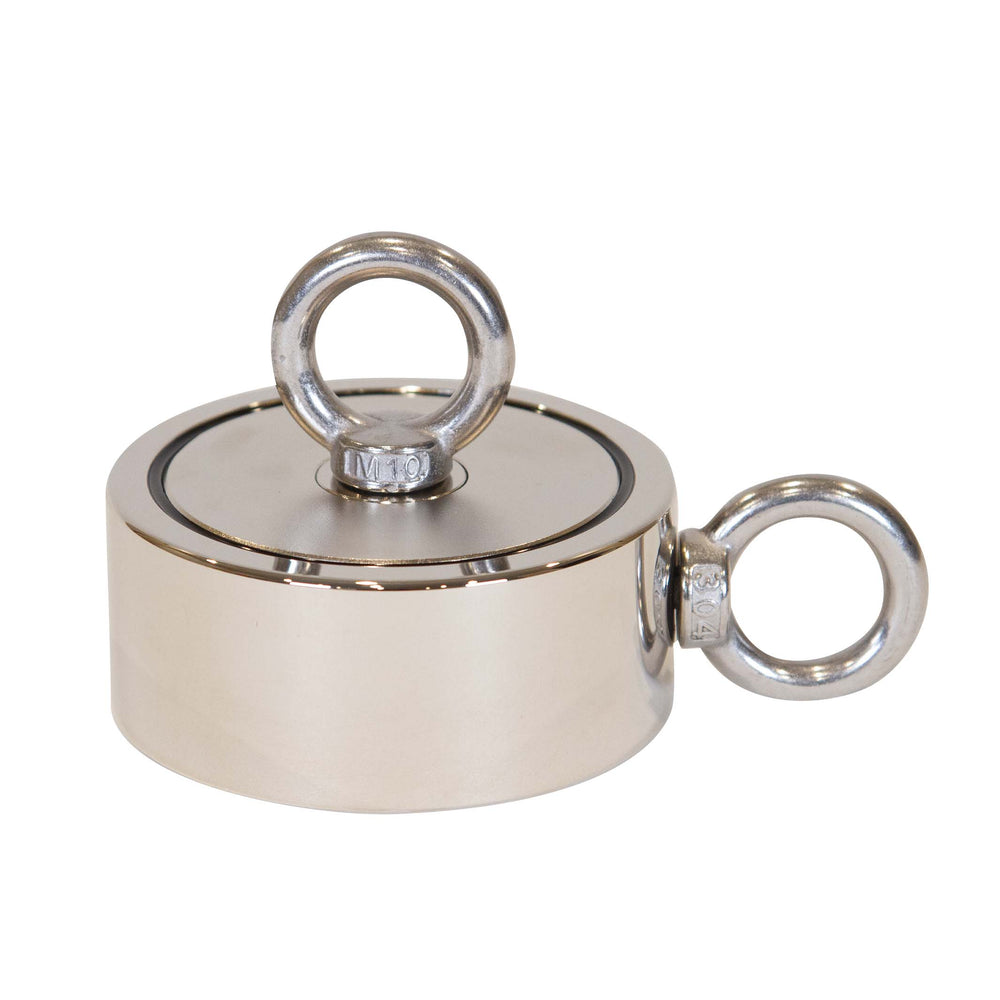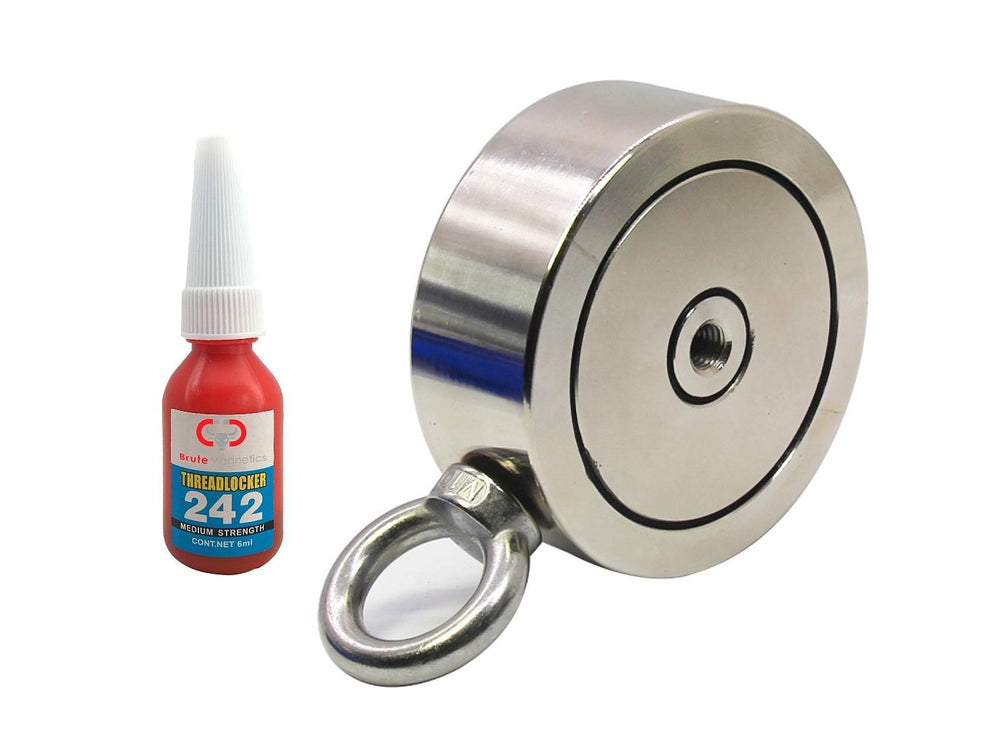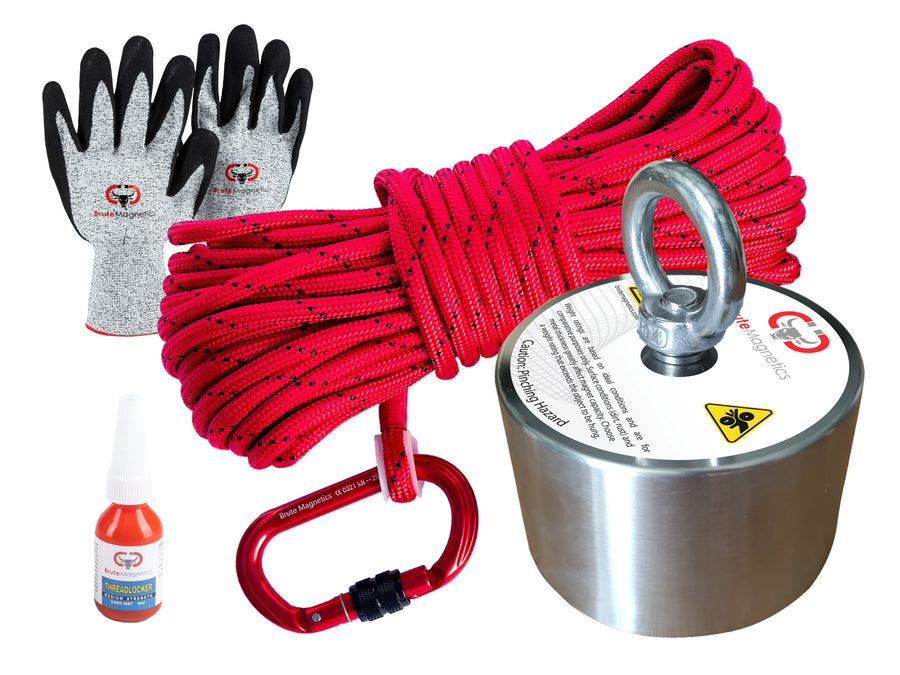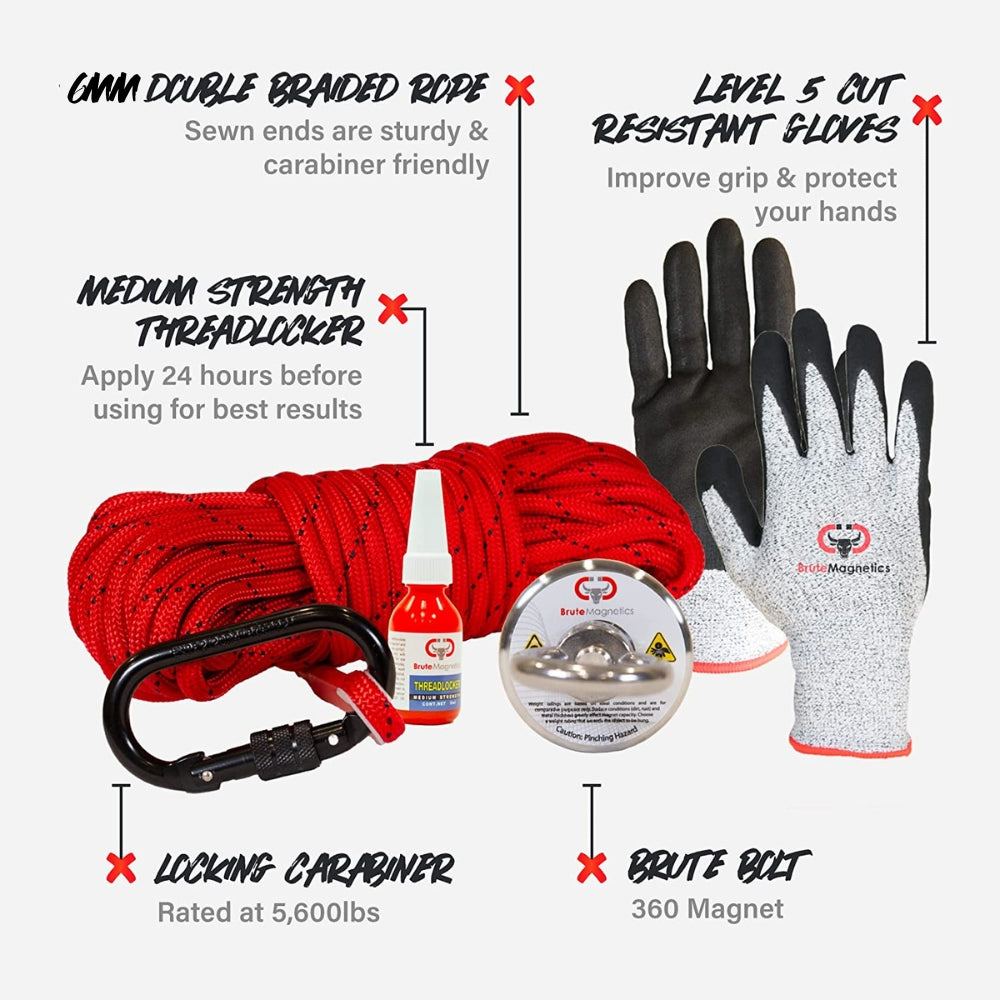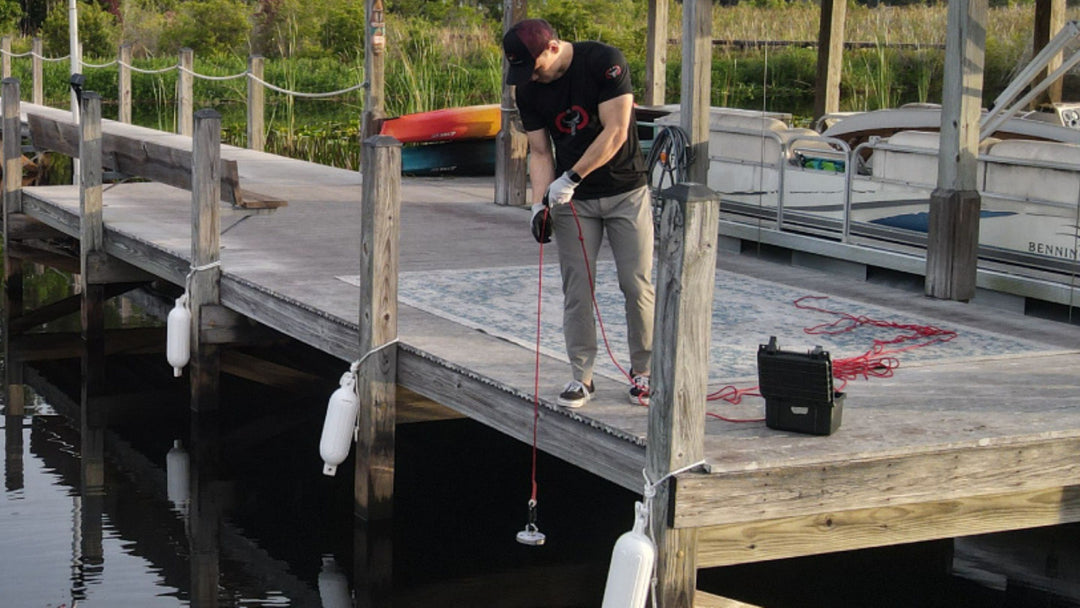Tips & Tricks
YOUR FIRST TIME OUT:
You’re on cloud nine right now because you’ve just unpacked your new magnet and can’t wait to get it in the water.
First things first..
 USE THE THREADLOCKER that came with your magnet
USE THE THREADLOCKER that came with your magnet 
Just apply 1 or 2 drops to the threads of the eyebolt and hand-tighten it, then allow it to cure for 24 hours (indoors) before use.
Securing your magnet:
GOOD PRACTICE: Attach the rope directly to the magnet by tying a knot through the eyebolt. The Palomar knot is a strong, reliable knot that is easy to tie.

BETTER PRACTICE: Attach your rope to a Brute Magnetics locking carabiner using the previously mentioned knot(s) and lock the carabiner to the eyebolt.
BEST PRACTICE: Avoid knots altogether and use one of our Brute Magnetics looped and sewn-end ropes which includes a locking carabiner!
Secure your line
Make sure to tie the free end of your line to a railing, post or any secure object before launching your magnet. Few things are more heartbreaking than watching your magnet and line say goodbye forever as they disappear from view.
We also recommend that in spite of your new found magnet fishing confidence and self esteem, under no circumstances should you use yourself as the secure object, DO NOT TIE THE ROPE TO YOU!!
FINDING A GOOD LOCATION:
Any place that has a lot of foot traffic near a body of water is bound to yield good finds. Some examples are:
- Public parks with lakes or ponds.
- Boat launches
- Fishing Piers
- Docks
- Marinas and boat slips
- Recreational waterways
- Under bridges, overpasses and railways
- Wells
- Canals
Check out Bridgehunter.com for old bridges in your area.
Always get permission before entering private property.
Google maps is another way to scout potential fishing spots.
“Map view” highlights bodies of water, rivers and creeks in blue so they’re really easy to spot.
Once you've chosen an area, switching to “satellite view” shows you photographic images that let you look for piers, docks, walkways and the like. Then of course, you can get directions on how to get there.
HUNTING TECHNIQUES, TIPS AND TRICKS:
Get a feel for new areas before you throw out too far. Rocks are the enemy! If there aren't very many than you might as well try your luck but if it's too rocky, you’ll probably want to move on.
Start by dropping in close to where you are and test the terrain by hopping or jigging your magnet. This is especially effective with a single sided magnet but works with a double sided as well, although they are designed primarily for dragging. Either way, it doesn't take long to get the hang of it and start reaping the rewards!
Unlike fishing with a rod and reel, with magnet fishing there isn't a need to “reel in” quickly. It is better to pull in at an easy, relaxed pace and pay attention to when the resistance in your rope changes. Eventually, you will be able to discern differences between mucky and gravelly areas as well as knowing when you're caught on a tree limb versus encountering some rocks. One thing you’ll always be able to recognize is the unmistakable clank of your magnet latching onto something metallic! When this happens, try to finesse it in so it doesn't become dislodged. Also, remember that most objects lose buoyancy once they break the surface and the load on the magnet increases which is also why you may want to invest in a Brute Magnetics grappling hook.
Not too many finds are quite as exciting as when you pull up an actual weapon, especially guns and knives. If you find something that could have possibly been used in a crime then discarded in the water, you will want to notify the local authorities so they can check it out. Even if they decide to confiscate it, they can tell you the steps to take to reclaim it if it is not connected to a crime.
Hunt often, inspect often. The more you cast, the more likely you are to generate finds! You will likely cast your magnet dozens if not hundreds of times in one outing so check the eyebolt frequently to make sure it hasn't loosened. Also avoid dragging your magnet over concrete railings, rough surfaces and sharp objects as that can cause fraying or weakening at that point. The heat shrink tubing on the rope is to protect the stitching from abrasion; it will eventually loosen and come off. If and when it does simply apply duct tape or similar over the exposed stitching.
HOW TO GET UNSTUCK:
It's not unusual for your magnet to get stuck; sometimes on a heavy object (like a metal pier column) or wedged between some rocks. When this happens, panic will immediately ensue but you’re a level-headed Brute magnet owner so take a few calming breaths and try these solutions;
- Try pulling firmly and steadily but not with all your might to assess if you're freeing it or making it worse.
- Pull from different angles (for example, the other end of the pier or the opposite side of the boat launch.)
- Put a lot of slack in your rope and let the current (if there is one) work for you, moving your line into a new position.
- If it’s safe and you can swim, go in after it! Some snorkeling gear will make this a fun and relatively effortless endeavor. You can actually pull yourself down the line directly to the magnet to visually assess the situation and free your magnet or you can stay on the surface and swim your line over and then past the point of hang up and free it from a different vantage point.
- If all else fails, you might try a more aggressive approach with a bumper winch or come along. But beware, this can possibly stretch your rope to the breaking point.
KEEP MAGNET FISHING FUN FOR EVERYONE:
Magnet fishing is just beginning to really take off all over the world and we want it to remain a fun way to find interesting things while also helping to clear our waters of junk and debris. What we don’t want is for it to be seen by anyone as bothersome, intrusive or becoming a nuisance. Simply being courteous and considerate of others while magnet fishing will go a long way (practicing “magnetiquette” if you will.) Some things you can keep in mind are:
SHARE SITES: Remember, where there’s water, there are often other people trying to enjoy themselves by swimming, fishing or just relaxing. Just remember that you are in a shared area with other people that want to have a good time too!
COMMUNICATE: If someone is already at a site when you arrive you might try describing what you’ll be doing and make sure it won't infringe on them. It's always appreciated, especially by anglers!
OBEY THE LAWS: If a sign says “Private Property,” always get permission first. If it says “No Trespassing”, then go ahead and find a different spot
LEAVE IT LIKE YOU FOUND IT: If you pull it out of the water you have become the new owner, if you throw it back or leave it behind, you have become the new litterbug! Whether your finds are useful or junk, you have plenty of options.
KEEP IT: You will be amazed at how quickly you will amass enough metal to make a few bucks at the local scrapyard to put towards your next magnet!
DISPOSE OF IT: You can often find a nearby trash can or dumpster in most public places. If not, at least stack it neatly in an unobtrusive area and try to notify maintenance personnel or perhaps a friend who can help you haul it away. There is also a growing online community that you can find on Facebook and Instagram called “Dippers and Scrappers'' that has listings of scrappers ready to haul away your finds for free!
CLEAN UP AFTER YOURSELF: Most finds come out of the water with plenty of rust, silt and debris that quickly accumulates. Take a few minutes to fill a 5 gallon bucket with water and rinse the area well before you go. Leave no trace!





